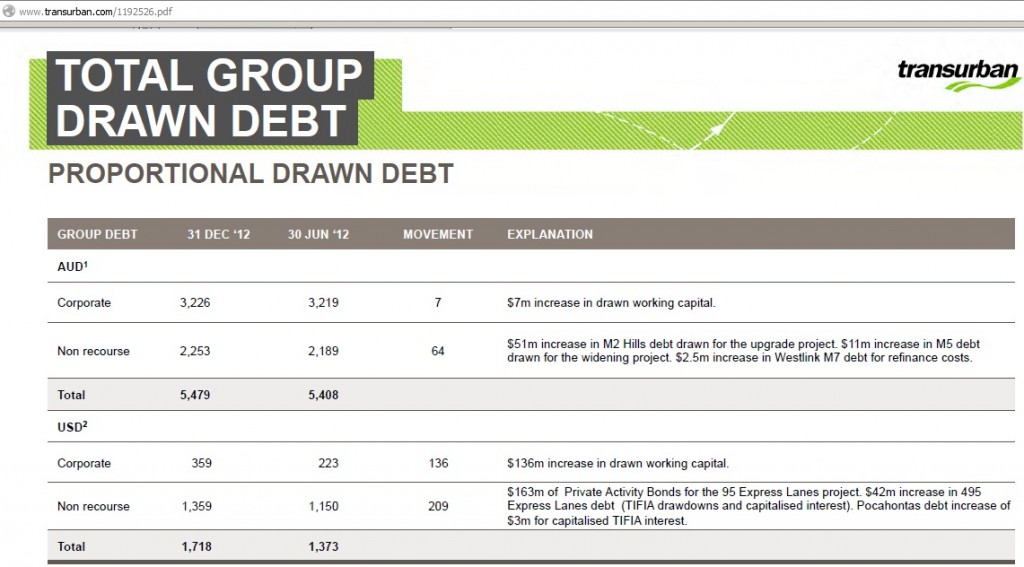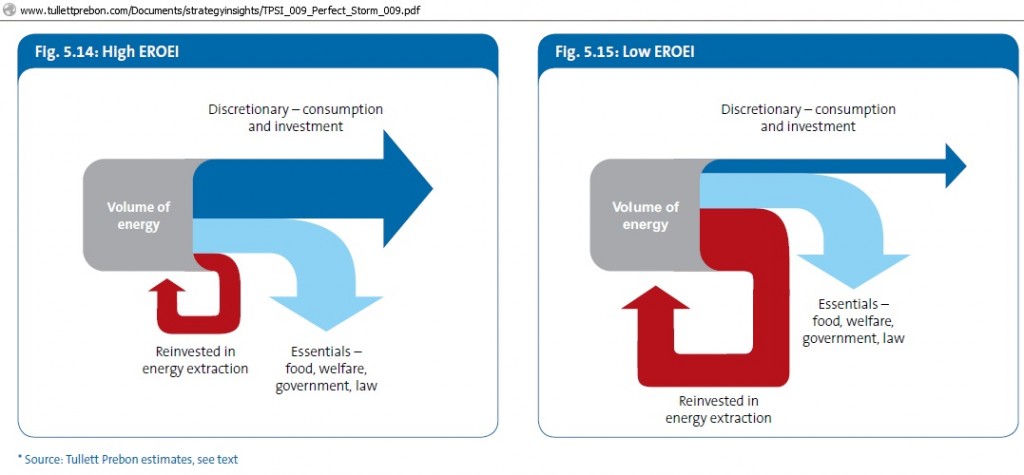At a recent ITLS seminar, Infrastructure NSW’s chairman Nick Greiner could not show calculations how Sydney’s existing toll-way debt, not to mention future debt from proposed new toll-ways, will ever be paid back. At present, debt is just rolled over. On top of the debt problem we have peak oil, the impact of Middle East unrest on oil supplies and global warming. None of these risks was analysed or quantified.
 http://sydney.edu.au/business/itls/research/past_seminars/2013
http://sydney.edu.au/business/itls/research/past_seminars/2013
No business case
This presentation was very disappointing. One would have expected – from a team of 20 professional planners – a perfectly presented business case for INSW’s 20 year Infrastructure Strategy “First Things First”, in particular about the proposed extension of Sydney’s toll-way network as shown in Fig 6.3:
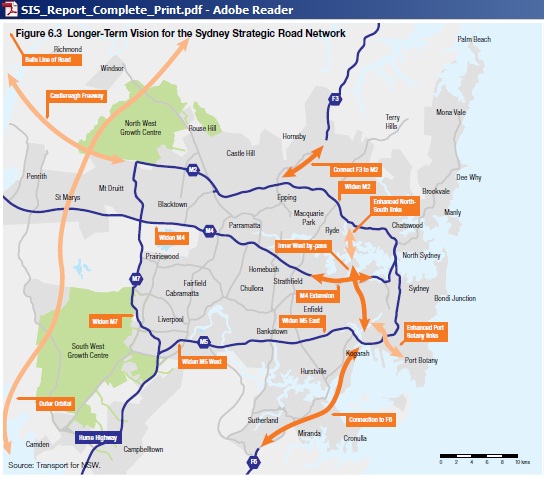 http://www.infrastructure.nsw.gov.au/state-infrastructure-strategy.aspx
http://www.infrastructure.nsw.gov.au/state-infrastructure-strategy.aspx
Instead, it was rather a chat, without the usual slides, based on the view of a linear world with endless economic growth, unlimited oil and energy supplies and no global warming. INSW sees itself as an independent advisor, somehow floating in free space between the “silos” (Greiner jargon) of government departments on one hand and the private sector on the other hand, coughing out the money for INSW’s proposed projects.
When asked in Q&A how he can be confident that new debt required for new tollways proposed can be paid back, given that Transurban can’t pay back its debt, Nick did not show any calculations how that could be achieved, but diverted attention away from new projects by conceding past failures as was reported already in September 2012 in this video:
User-pays fix to the provide transport billions
Greiner: “What happened is you got a substantial gaming effect where between the banks, the engineering consultants, the traffic consultants, the construction companies, everyone tried to get their patronage estimates up and get the banks to fund these estimates, because that’s how you won , and that’s how you could pay whoever the State treasurer was lot’s of money upfront. So, yeah, it is the case that Bilfinger Berger was in that project and lost money on it. I don’t.. that’s actually a qualification, dare I say it, for my involvement in this position”
At the seminar, with that qualification, Nick pointed out that no tax-payer money was lost in these schemes, as if it is no problem when investors lose money. The ITLS audience did not respond to this shocking dis-respect for savings of others.
In order to illustrate the problem, let’s have a look at Transurban’s latest debt position, coincidentally published in an investor presentation on the same day Greiner’s seminar was held:
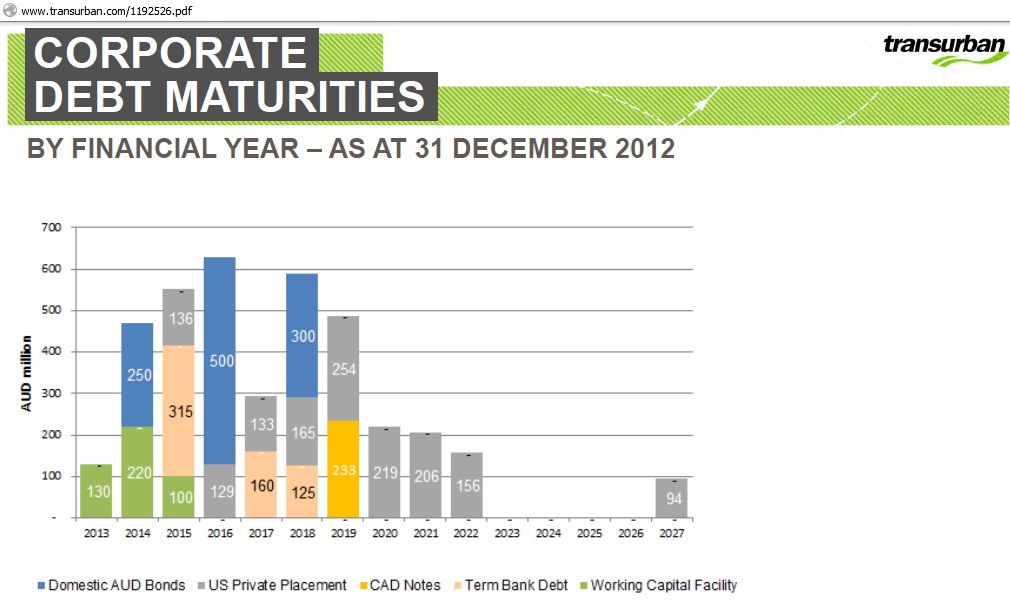 http://www.transurban.com/1192526.pdf
http://www.transurban.com/1192526.pdf
We can see that Transurban faces a mountain of debt ahead, costing 6.5% to 7 % in AUD and 3.6% to 5.3% in USD and which is continuously being rolled over into new debt.
Debt can kicked down the toll-road
In the seminar, Nick mentioned that super annuation funds have sufficient money but that good returns are a problem. However, he could not or did not want to analyse why that is so. Obviously, tolls are too low to allow toll-way operators to pay back debt within, say, a reasonable 20-25 years. Transurban has now successfully pushed repayment of some asset debt far into the future, possibly beyond the life of these assets, until 2048, a period when our oil based economy the way we know it has long disappeared and when traffic on toll-ways would be thin.
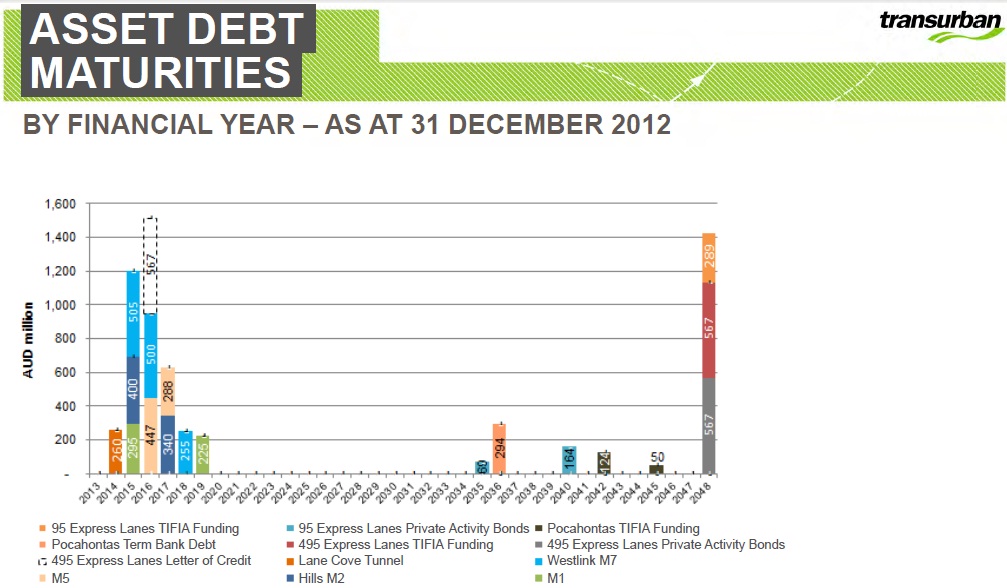 Graph showing distant sinks for investor’s capital.
Graph showing distant sinks for investor’s capital.
Energy inefficiency of toll-ways
Greiner also mentioned that productivity of existing infrastructure has to be increased, without, however, defining how productivity is measured and without applying this principle to his toll-ways. The best way to do that would be of course to introduce mandatory car pooling by converting existing lanes to high-occupancy (HOT) lanes, because that would reduce congestion without big physical investments like widening or additional tunnelling. In fact, car-pooling would be the only way to neutralize the damaging effect of a 3-4 fold increase of oil prices on the economy which occurred since peak oil started in 2005.
Transurban’s new express lanes on the Interstate 495 Beltway project South-West of Washington represent additional capacity and are therefore NOT the above mentioned solution.
No modelling was presented how car pooling, not to mention petrol rationing, would affect traffic and toll incomes.
In the end what matters is the energy efficiency of an operation. How about measuring productivity of tollways by considering oil (or energy) as an input and toll-income as an output:
(1) In physical terms:
person km travelled or ton-km freight per litres of oil (or KWh primary energy)
(2) In financial terms:
The ratio of toll-revenue in $ divided by the cost of oil (or KWh primary energy) in $
In order to come up with a priority list of transport infrastructure investments the above efficiency criteria would have to be applied to different modes of transport. Toll-ways would rank very low in this regard.
Energy efficiency is real driver of economy
That energy efficiency is the real driver of the economy is highlighted in this research by Tim Morgan from Tullett Prebon Research in:
Perfect Storm: Energy, finance and the end of growth
http://tullettprebonresearch.com/2013/01/21/perfect-storm-report-now-live/
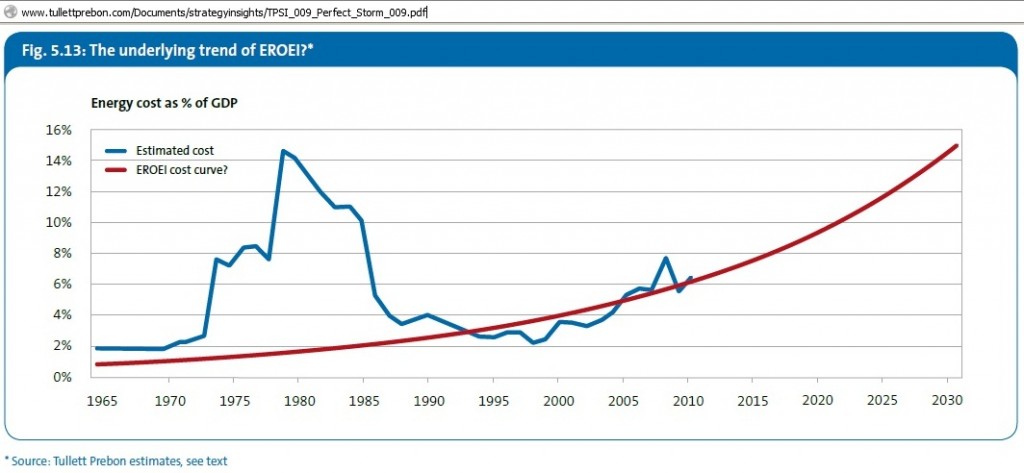 Ever increasing percentages of the world’s GDP have to be spent on providing energy.
Ever increasing percentages of the world’s GDP have to be spent on providing energy.
We can see the impact of the 1st and 2nd oil crisis in the 1970 (US peak in 1970 and Iran peak in 1975/76). It took 20 years to get costs down, as a percentage of GDP. But now we have the global oil peak.
This graph shows how increasing amounts of energy have to be used to convert primary energy into usable energy, thereby reducing the amount of energy available for discretionary consumption.
Of course, all this is not on the radar of INSW.
Chapter 16
Nick specifically mentioned chapter 16 of “First things first”. Let’s have a look at some of the points (p 198)
“The distinction between funding and financing is an important one that is sometimes lost in public commentary:
• All new infrastructure is ultimately funded via taxation or user charges. Private financing in its own right does not create more money for infrastructure development.”
Comment: Except that debt financing becomes funding when debt (i.e. the principal) is not paid back
“• Infrastructure NSW proposes its priorities are delivered within a sustainable budgetary framework by using the following six funding strategies:
–– reduction of public transport subsidies,”
Comment: How about cancelling the M5 cash back scheme in which private motorists get a rebate on the tolls they pay when using the M5?
http://www.rta.nsw.gov.au/usingroads/motorwaysandtolling/m4m5_cashbackscheme.html
“–– tolls on new and upgraded motorway links”
Comment: Here are the toll-candidates:
F3
Pacific Highway
http://www.rta.nsw.gov.au/roadprojects/projects/pac_hwy/
Hunter Expressway
http://www.rta.nsw.gov.au/roadprojects/projects/hunter_expressway/index.html
Hume Highway
http://www.rta.nsw.gov.au/roadprojects/projects/south_western_region/hume_hway_dup/index.html
Princess Highway
http://www.rta.nsw.gov.au/roadprojects/projects/princes_hway/index.html
The tolls should go back to where the investment dollars came from: the State and Federal budgets, but NOT to be spent on yet more toll-ways. Anyway, it would take decades to pay back construction costs.
INSW has kicked some own goals here.
No risk analysis on oil and global warming
At the seminar, I distributed graphs showing the peaking of global crude oil exports from this post:
4/2/2013 Shrinking crude oil exports – a tough game for oil importers
http://crudeoilpeak.info/shrinking-crude-oil-exports-a-tough-game-for-oil-importers
Middle East
This website puts seminars always in the context of what is happening in the world at the time, to highlight how provincial, blue eyed and remote from reality these presentations usually are. One day before the seminar:
 http://en.wikipedia.org/wiki/2011%E2%80%9312_Strait_of_Hormuz_dispute
http://en.wikipedia.org/wiki/2011%E2%80%9312_Strait_of_Hormuz_dispute
International Militaries Return to Gulf to Conduct Mine Countermeasures Exercise
4/2/2013
Navies and government agencies from more than 20 nations spanning four continents will come together in May 2013 to participate in a defensive mine countermeasures exercise in the Middle East’s international waterways.
http://www.centcom.mil/press-releases/international-militaries-return-to-gulf-to-conduct-mine-countermeasures-exercise
Nature will not give NSW a break on global warming
The conventional oil peak of 2006 is now being disguised by adding non-conventional oil which of course will accelerate global warming. What’s worse, we find in “First things first” following recommendation:
“Infrastructure NSW recommends increased capacity in the Hunter Valley Coal Chain through the Liverpool Ranges”, p 140
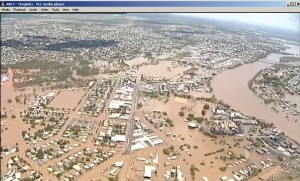 The Queensland town of Bundaberg flooded by cyclone Oswald in January 2013
The Queensland town of Bundaberg flooded by cyclone Oswald in January 2013
http://en.wikipedia.org/wiki/2013_Eastern_Australia_floods
How many floods do we need until INSW studies and learns global warming science?
TONY JONES: …. why worry about carbon dioxide when water vapour is a stronger greenhouse gas and actually occurs naturally?
JAMES HANSEN: Yeah, that’s the screwiest argument which keeps being made again and again and again. The amount of water vapour in the atmosphere is determined by the atmosphere’s temperature, everyone should know that. Look at the difference between winter and summer.
As you go to a warmer climate the atmosphere holds more water vapour because at the places where the humidity reaches 100 per cent the water vapour falls out as water or snow. And therefore, as the planet becomes warmer, the atmosphere holds more water vapour.
That’s why we get heavier rain falls as the planet gets warmer. So this water vapour is an amplifying feedback. It makes the greenhouse effect much stronger. But it’s not something that just changes on its own accord; it changes in response to the temperature changes.
http://www.abc.net.au/lateline/content/2008/s2764523.htm
Nick also mentioned that he is looking not only at roads and airports but other infrastructure as well:
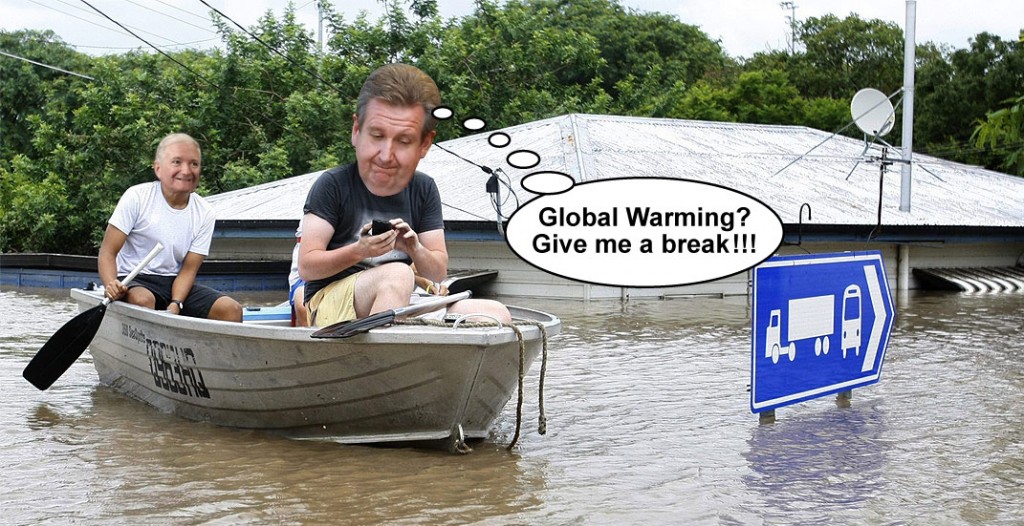 NSW Premier and ex-Premier on discovery tour for new infrastructure requirements
NSW Premier and ex-Premier on discovery tour for new infrastructure requirements
(picture kindly provided by: http://ianmcpherson.com/)
BARRY O’FARRELL: Let’s not turn this near disaster, this episode that has damaged so many properties and other things, farm properties and other things, into some politically correct debate about climate change. Give me a break.
http://www.abc.net.au/lateline/content/2013/s3679051.htm
For the record, after the seminar I handed over to Nick Greiner 2 hard copies of this flyer:
http://crudeoilpeak.info/wp-content/uploads/2013/02/Flyer_ITLS_5_Feb_2013.pdf
It contains the question how 12.7 million Australian motorists, 2.6 million LCV drivers and 0.5 million truckies will compete with the growing number of their Chinese counterparts.
 http://www.caam.org.cn/newslist/a101-1.html
http://www.caam.org.cn/newslist/a101-1.html
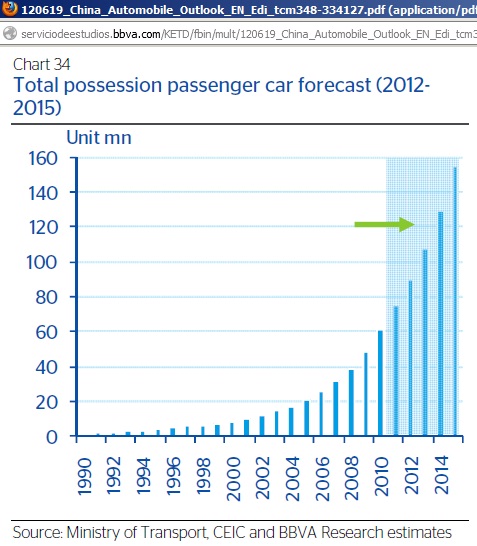 http://serviciodeestudios.bbva.com/KETD/fbin/mult/120619_China_Automobile_Outlook_EN_Edi_tcm348-334127.pdf?ts=1322013
http://serviciodeestudios.bbva.com/KETD/fbin/mult/120619_China_Automobile_Outlook_EN_Edi_tcm348-334127.pdf?ts=1322013
There will be limits to growth in the Chinese car fleet, e.g. by car plate lotteries
Beijing continues to limit car purchase
19/12/2012
http://www.chinaautoreview.com/pub/CARArticle.aspx?ID=8277
Nevertheless, the above graph gives an idea how fierce the competition will be for fuel, especially as Sydney will have no refinery by 2014
Summary and conclusion:
Much of Greiner’s talk was a justification for the existence of INSW and its expenditure. Calculations on the economic and financial viability of toll-ways and other oil-dependent infrastructure were not presented. Sensitivity and risk analysis is unheard-of. It seems as if INSW is yet another silo, in which its members are completely disconnected from the realities of debt, peak oil and global warming. In any case, INSW has put itself already on the wrong side of history’s ledger.
Related links:
7/11/2012 Australian infrastructure bosses want more traffic on motorways
http://crudeoilpeak.info/australian-infrastructure-bosses-want-more-traffic-on-motorways
6/7/2012 Brisbane Airport Link: another tollway miracle of growing debt and assumed traffic growth (part 1)
http://crudeoilpeak.info/brisbane-airport-link-another-tollway-miracle-of-growing-debt-and-assumed-traffic-growth-part-1
Clem 7 road tunnel in Brisbane
http://crudeoilpeak.info/i-told-you-so/north-south-bypass-tunnel-clem7-brisbane
